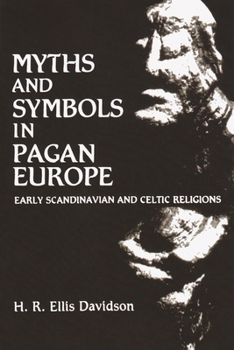Myths and Symbols in Pagan Europe
Most people know of Valhalla, the World-Tree and the gods of Norse mythology, or the strange hunts and voyages of the ancient lrish tales. Yet few people realise the significance of the similarities and contrasts between the religions of the pre-Christian people of north-western Europe.
Format:Paperback
Language:English
ISBN:0815624417
ISBN13:9780815624417
Release Date:June 1988
Publisher:Syracuse University Press
Length:280 Pages
Weight:0.15 lbs.
Dimensions:0.7" x 6.0" x 9.0"
Customer Reviews
5 ratings
The standard by which others are judged?
Published by Thriftbooks.com User , 15 years ago
This work is typical of H.R. Ellis Davidson. Well researched and written. The comparative nature of this work can, at times, make it seem a little disjointed but it was an enjoyable read. The only thing that would have made it better was if she had included Continental Germanic tribes as well. Overall an excellent resource.
Heathan Lore
Published by Thriftbooks.com User , 16 years ago
Here the lore of Northern Heathanism is paired and compaired with the lore of the Ancient Celts. I would recomend this book to all Asatruar looking to examine more closely, the Lore of our Folk.
The Mysterious Spirit of my Hearth Inheritance
Published by Thriftbooks.com User , 17 years ago
This book is mainly concerned with the format and content of pre-Christian Scandinavian religion, using Celtic and Germanic equivalents as a means of reference, support and comparison. I first became aware of Scandinavian culture during my schooldays in North-East British Northumberland, and the lessons were mainly concerned with depicting the savagery of the Viking raiders, the terrible `dragon-headed' long-ships, and their rape, pillage and plunder of civilized Anglo-Saxon Christian settlements. This image of barbaric ice-warriors filled my imagination until the mid-eighties when excavations and archeological discoveries at Coppergate in York revealed many interesting and highly cultured facets of Viking life in the early medieval period. Much of these discoveries and subsequent research was installed as a permanent museum now called `Jorvik Viking Centre.' A decade later I was fortunate enough to visit Bergen in Norway and experience Scandinavian culture and history first hand, the Bryggens Museum is a showcase of finds from the earliest settlements and includes ceramics, rune inscriptions, artifacts and the remnants of a principally shipping and commercial society up to the Middle Ages. `Myths and Symbols in Pagan Europe' provided me with a carefully researched and detailed account of the spirituality of the Scandinavian peoples, and which brought to maturity all my previous thoughts and experiences, to an understanding which gives considerable credit to those communities for their important cultural legacy in Western Europe. Davidson has used the medieval literature, myths and legends of Iceland and Ireland as the primary reference source for this book, in combination with archeological research papers and sources, and iconography of pre-Christian Western European culture. Her main inspiration appears to come from many scholars of Celtic history including Nora Chadwick, Kenneth Jackson and Anne O'Sullivan, although the principle thesis of the this research is prompted by Georges Dumezil (1898-1986) the religious historian who specialized in the analysis of Indo European civilization, who asks; "Is it possible to fit these Norse and Irish legends into a general pattern of Indo-European religious beliefs, extending back far into prehistory?" This question it seems, is the answer that Davison was seeking to explore within her work, and she does so with imagination, clear perception and a satisfying conclusion. With a broad yet defining sweep she manages to assess and investigate seven principle areas of interest; sacred places and sanctuaries, feasting and sacrifices, warriors, codes and rites and battle, land spirits, deities and ancestors, prophetic knowledge, divination and the priestly caste, cosmology and the other worlds, and finally the ruling gods, goddesses and divine pantheons. Davidson begins with the earliest sources of a broad Indo-European culture, the archeological sources of Halstatt and La Tene circa 800 BCE to 200 CE, and fo
Great book!
Published by Thriftbooks.com User , 19 years ago
Davidson has done a great job with this book in setting out to show the similarities in the religious/cultural practices and beliefs of the Germanic and Celtic heathens. My personal belief is that the Gods of the Norse and other Germanics are the same Gods as those that the Celts worshipped, even if the names, lore and rites differed in various ways. She draws heaviest from the Irish sources instead of Welsh, Brit and continental Celts for drawing comparisons to Germanic peoples but even those are far from being totally neglected. Personally I don't how anybody could deny, even coming from the academic egghead perspective , that Odin and the Irish/Welsh/Gaelic Lugh/Lleu are anything other than the same God after reading this book. From an academic/historical perspective this is argueably the best book ever written on Odinsim.
Ellis Davidson has a winner! First class research!
Published by Thriftbooks.com User , 26 years ago
This is the *best* comparison/analysis of Scandinavian/Celtic interface in pagan times. A "must have" for the Celticist or early-period Scandinavian specialist. My copy doesn't leave my house. Period.





